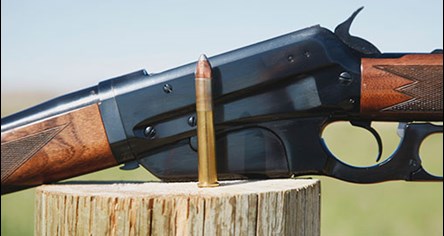
 As I write this I can smell the ammonia-based bore solvent on my hands from cleaning my Model 95 Winchester chambered in .405 Win. I had taken it with me to compete in a side match at our local CAS shoot Saturday. It was an interesting match—“shoot whatcha brung,” provided that it is a lever-action or single shot rifle with iron sights. The match was simple: Each shooter provided his or her own target in the form of a water-filled, one-gallon jug. The shooter would place the jug where he or she wanted to shoot it. The Range Officer would laze the target but not tell the shooter the range. The shooter had up to three shots to hit the target. A first-shot hit scored three times the lasered range; second shot hit yielded two times the range and third shot hit was one times the range.
As I write this I can smell the ammonia-based bore solvent on my hands from cleaning my Model 95 Winchester chambered in .405 Win. I had taken it with me to compete in a side match at our local CAS shoot Saturday. It was an interesting match—“shoot whatcha brung,” provided that it is a lever-action or single shot rifle with iron sights. The match was simple: Each shooter provided his or her own target in the form of a water-filled, one-gallon jug. The shooter would place the jug where he or she wanted to shoot it. The Range Officer would laze the target but not tell the shooter the range. The shooter had up to three shots to hit the target. A first-shot hit scored three times the lasered range; second shot hit yielded two times the range and third shot hit was one times the range.
I had put some red dye in my jug, and at some 92 yards I hit it with the second shot. The results were impressive; the 300-grain soft point at some 2,200 fps made the jug come apart nicely. See the embedded video. I did not win the side match; my friend who goes by Yakima Red in CAS shooting, beat me by hitting his 83-yard jug with the first shot from his 1894 Winchester in .30-30.
The .405 Win. cartridge came about in 1904, chambered in the Winchester Model 1895 rifle. Until the advent of the .444 Marlin it was the most powerful cartridge ever chambered in a lever-action rifle. President Theodore Roosevelt was a huge fan of the .405 Winchester and took a pair of them on his famous African safari, pronouncing the cartridge as big medicine for lion. The cartridge and the rifle enjoyed moderate success here in the States as a bear and elk rifle. It was dropped from the Winchester stable in 1936, and ammo companies sealed its doom in 1955, ceasing loading it.
One of the reasons the .405 Win. did not endure is that it used an almost one-of-a-kind bullet—a .4115-inch diameter, 300-grain soft point. Manufacturers usually despise a one-of-a-kind anything because it limits production. Better to have bullets of, say, .30 caliber—.308-inch diameter—that can be loaded in a variety of cartridge cases. Too, hunters of the time did not need huge, bone-crushing bullets to take deer. They really liked the speedy lightweight bullets offered in .25, .270, 7 mm and .30 calibers that smacked deer down at a quarter mile. Another tick against the .405 was the Model 1895 rifle and its stock design that tended to accentuate the recoil unpleasantly.
A few years ago Browning/Winchester reintroduced the Model 1895 rifle, and eventually they made a limited run of the rifle in a takedown configuration chambered in .405 Win. to commemorate Roosevelt’s safari. I simply had to have one, and I bought one as soon as it became available. Though made by Miroku in Japan, its quality and craftsmanship rivals anything to come from the United States in quite a while. Hornady has solved the ammo dilemma and loads the cartridge today.
I have taken it on a couple of hunts but never been able to close the deal on a critter with it yet—something I need to reconcile. Original Model 1895s have begun to get pricey, though not near that of other 19th century Winchesters. An original 1895 Model in .405 commands a premium, but you can still find a repo occasionally.



































